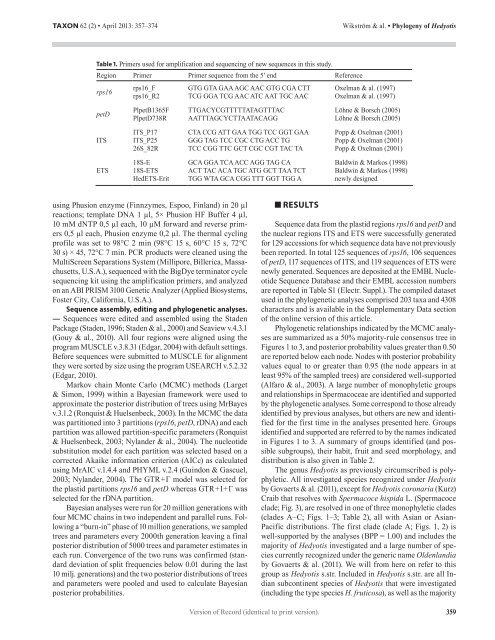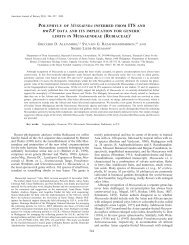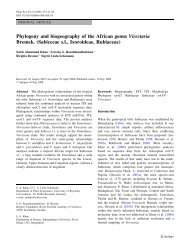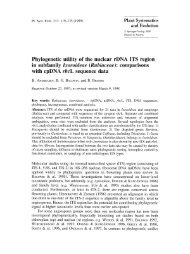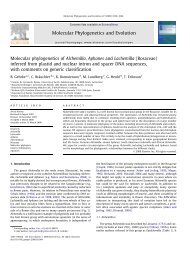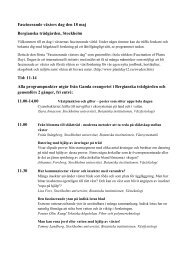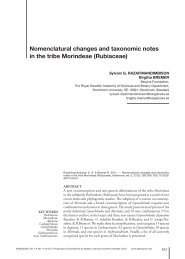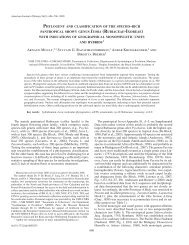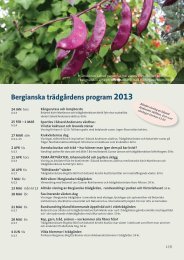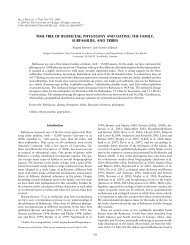Wikström & al. • <strong>Phylogeny</strong> <strong>of</strong> <strong>Hedyotis</strong>TAXON 62 (2) • April 2013: 357–374small (Bremekamp, 1952, 1966; Verdcourt, 1958; Robbrecht,1988, 1993) or as a very large group (Bremer, 1996; Bremer& Manen, 2000), and sometimes including the tribes Hedyotideae,Knoxieae, Manettieae, and Triainolepideae. Followingthe results from the most recent phylogenetic analyses(Dessein, 2003; Kårehed & Bremer, 2007; Kårehed & al., 2008;Groeninckx & al., 2009) and the most recent classification <strong>of</strong>the family (Bremer & Eriksson, 2009), <strong>Spermacoceae</strong> are heretreated as a tribe <strong>of</strong> ca. 1000 species and 60 genera, includingManettieae and most genera <strong>of</strong> Hedyotideae, but excludingKnoxieae and Triainolepideae (Bremer & Eriksson, 2009).Using plastid DNA data and combined plastid and nuclearrDNA data Groeninckx & al. (2009) and Kårehed & al. (2008)recently analyzed the phylogenetic relationships <strong>of</strong> <strong>Spermacoceae</strong>.Contrary to previous analyses they adopted a globalperspective on <strong>Spermacoceae</strong> and their analyses included abroad sampling <strong>of</strong> taxa covering most <strong>of</strong> the geographic andtaxonomic diversity <strong>of</strong> the group. While their analyses found alarge number <strong>of</strong> well-supported groups within <strong>Spermacoceae</strong>,they (Kårehed & al., 2008; Groeninckx & al., 2009) alsohighlighted considerable problems with our contemporarytaxonomy. Many <strong>of</strong> the smaller segregate genera, confined torestricted geographic regions, were supported as monophyletic,but at the same time their analyses indicated problemswith some <strong>of</strong> the larger, and less easily characterized, generasuch as Oldenlandia and <strong>Hedyotis</strong>. Oldenlandia in particularwas problematic and representatives included in their analysesshowed a broad range <strong>of</strong> unexpected relationships (Kårehed& al., 2008; Groeninckx & al., 2009).There was no support in the analyses by Kårehed & al.(2008) and Groeninckx & al. (2009) for circumscribing <strong>Hedyotis</strong>in a way to also include American and Polynesian taxa (Merrill& Metcalf, 1942; Fosberg, 1943; Fosberg & Sachet, 1991; Dutta& Deb, 2004). <strong>Hedyotis</strong> fruticosa L., the type species <strong>of</strong> thegenus from Sri Lanka, was grouped with strong support witha few Asian and Micronesian species, and the authors arguedthat the generic name <strong>Hedyotis</strong> probably should be restrictedto this smaller group (Kårehed & al., 2008; Groeninckx & al.,2009). It is possible that this group <strong>of</strong> Asian and Micronesianspecies corresponds to a group <strong>of</strong> species recognized alreadyby Wight & Arnott (1834: 405–418) as <strong>Hedyotis</strong> sect. DiplophragmaWight & Arn. Surveying Asian and Pacific species <strong>of</strong>the genera <strong>Hedyotis</strong> and Exallage Bremek., a large number <strong>of</strong>species from Sri Lanka, China, and Micronesia were associatedwith this group by Terrell & Robinson (2003), and this possibilitywas also discussed briefly by Groeninckx & al. (2009).The sampling in the two studies by Kårehed & al. (2008) andGroeninckx & al. (2009) was however limited and resolvingthe taxonomic problems in this group required a more exhaustivesampling. Pleiocraterium Bremek., for example, was notincluded in their analyses and may be closely related to otherAsian species <strong>of</strong> <strong>Hedyotis</strong> (Groeninckx & al., 2009). The generaExallage and Leptopetalum Hook. & Arn. were also absent intheir analyses (Kårehed & al., 2008; Groeninckx & al., 2009).Exallage was originally described by Bremekamp (1952), andincludes several species from Asia that have been suggestedto belong to <strong>Hedyotis</strong> (Ridsdale, 1998). Leptopetalum has alsobeen associated with <strong>Hedyotis</strong>, at least in a broad sense (seeFosberg & Sachet, 1991, for a discussion). Other unsampledgroups included the genera Neanotis W.H. Lewis (ca. 30 spp.)and Metabolos Blume (1 or 2 spp.).Building on the analyses by Kårehed & al. (2008) andGroeninckx & al. (2009) we initiated a phylogenetic analysisfocusing on the Asian and Micronesian species referred to as<strong>Hedyotis</strong> s.str. in their studies. Our primary aims are to bettercircumscribe the genus <strong>Hedyotis</strong>, and to identify some <strong>of</strong> therelationships within this group.Materials and MethodsTaxon sampling. — Taxa were sampled with two primaryobjectives: (1) to include as many species as possiblefrom <strong>Hedyotis</strong> s.str. (Kårehed & al., 2008; Groeninckx & al.,2009); and (2) to include as many taxa as possible from the tribe<strong>Spermacoceae</strong> that have been suggested to belong to <strong>Hedyotis</strong>,but that have not been included in any previous phylogeneticanalysis, or have not in some other way been shown to be distantlyrelated to <strong>Hedyotis</strong>.In total 203 accessions were included. The backbone <strong>of</strong>the datasets from Groeninckx & al. (2009) and Kårehed & al.(2008) remain, but the number <strong>of</strong> taxa from groups not in thefocus <strong>of</strong> the present analyses was significantly reduced. Sixtytwoaccessions from the analyses by Kårehed & al. (2008),twelve accessions from the analyses by Guo & al. (2011) and129 accessions not previously included in any phylogeneticanalysis were selected. Comprehensive information on speciesnames, voucher information, and references is given forincluded accessions in Table S1 (Electr. Suppl.).Following the first description <strong>of</strong> <strong>Hedyotis</strong> by Linnaeus(1753), there have been continuous disagreements over thedelimitation <strong>of</strong> the genus, particularly with respect to Oldenlandia.The two genera have <strong>of</strong>ten been treated as congeneric,and to make things worse, they have variously been treated aseither <strong>Hedyotis</strong> (Wight & Arnott, 1834; Fosberg, 1943; Fosberg& Sachet, 1991; Fosberg & al., 1993) or Oldenlandia (Hiern,1877; Schumann, 1891). Consequently, species described underone generic name (i.e., <strong>Hedyotis</strong>) almost certainly have a synonymunder the other (Oldenlandia) and by what name an individualspecies should be referred to is an almost arbitrarychoice. In order to be consistent, and without any preconceivedideas <strong>of</strong> what is right or wrong, we have chosen to apply thegeneric names <strong>Hedyotis</strong> and Oldenlandia to individual taxafollowing Govaerts & al. (2011).DNA extraction, amplification, and sequencing. — Totalgenomic DNA was extracted from silica-dried material and/or herbarium specimens using a standard cetyl trimethyl ammoniumbromide (CTAB) protocol (Doyle & Doyle, 1987),combined with the QIAquick PCR cleaning kit (Qiagen, Hilden,Germany) following the protocol specified by the manufacturer.Amplification and sequencing <strong>of</strong> the plastid regions rps16and petD, and <strong>of</strong> the internal and external transcribed spacers(ITS, ETS) <strong>of</strong> the nuclear rDNA were carried out using primerslisted in Table 1. Amplification reactions were performed358 Version <strong>of</strong> Record (identical to print version).
TAXON 62 (2) • April 2013: 357–374Wikström & al. • <strong>Phylogeny</strong> <strong>of</strong> <strong>Hedyotis</strong>Table 1. Primers used for amplification and sequencing <strong>of</strong> new sequences in this study.Region Primer Primer sequence from the 5′ end Referencerps16rps16_Frps16_R2GTG GTA GAA AGC AAC GTG CGA CTTTCG GGA TCG AAC ATC AAT TGC AACOxelman & al. (1997)Oxelman & al. (1997)petDPlpetB1365FPlpetD738RTTGACYCGTTTTTATAGTTTACAATTTAGCYCTTAATACAGGLöhne & Borsch (2005)Löhne & Borsch (2005)ITSITS_P17ITS_P2526S_82RCTA CCG ATT GAA TGG TCC GGT GAAGGG TAG TCC CGC CTG ACC TGTCC CGG TTC GCT CGC CGT TAC TAPopp & Oxelman (2001)Popp & Oxelman (2001)Popp & Oxelman (2001)ETS18S-E18S-ETSHedETS-EritGCA GGA TCA ACC AGG TAG CAACT TAC ACA TGC ATG GCT TAA TCTTGG WTA GCA CGG TTT GGT TGG ABaldwin & Markos (1998)Baldwin & Markos (1998)newly designedusing Phusion enzyme (Finnzymes, Espoo, Finland) in 20 µlreactions; template DNA 1 µl, 5× Phusion HF Buffer 4 µl,10 mM dNTP 0,5 µl each, 10 µM forward and reverse primers0,5 µl each, Phusion enzyme 0,2 µl. The thermal cyclingpr<strong>of</strong>ile was set to 98°C 2 min (98°C 15 s, 60°C 15 s, 72°C30 s) × 45, 72°C 7 min. PCR products were cleaned using theMultiScreen Separations System (Millipore, Billerica, Massachusetts,U.S.A.), sequenced with the BigDye terminator cyclesequencing kit using the amplification primers, and analyzedon an ABI PRISM 3100 Genetic Analyzer (Applied Biosystems,Foster City, California, U.S.A.).Sequence assembly, editing and phylogenetic analyses.— Sequences were edited and assembled using the StadenPackage (Staden, 1996; Staden & al., 2000) and Seaview v.4.3.1(Gouy & al., 2010). All four regions were aligned using theprogram MUSCLE v.3.8.31 (Edgar, 2004) with default settings.Before sequences were submitted to MUSCLE for alignmentthey were sorted by size using the program USEARCH v.5.2.32(Edgar, 2010).Markov chain Monte Carlo (MCMC) methods (Larget& Simon, 1999) within a Bayesian framework were used toapproximate the posterior distribution <strong>of</strong> trees using MrBayesv.3.1.2 (Ronquist & Huelsenbeck, 2003). In the MCMC the datawas partitioned into 3 partitions (rps16, petD, rDNA) and eachpartition was allowed partition-specific parameters (Ronquist& Huelsenbeck, 2003; Nylander & al., 2004). The nucleotidesubstitution model for each partition was selected based on acorrected Akaike information criterion (AICc) as calculatedusing MrAIC v.1.4.4 and PHYML v.2.4 (Guindon & Gascuel,2003; Nylander, 2004). The GTR + Γ model was selected forthe plastid partitions rps16 and petD whereas GTR + I + Γ wasselected for the rDNA partition.Bayesian analyses were run for 20 million generations withfour MCMC chains in two independent and parallel runs. Followinga “burn-in” phase <strong>of</strong> 10 million generations, we sampledtrees and parameters every 2000th generation leaving a finalposterior distribution <strong>of</strong> 5000 trees and parameter estimates ineach run. Convergence <strong>of</strong> the two runs was confirmed (standarddeviation <strong>of</strong> split frequencies below 0.01 during the last10 milj. generations) and the two posterior distributions <strong>of</strong> treesand parameters were pooled and used to calculate Bayesianposterior probabilities.ResultsSequence data from the plastid regions rps16 and petD andthe nuclear regions ITS and ETS were successfully generatedfor 129 accessions for which sequence data have not previouslybeen reported. In total 125 sequences <strong>of</strong> rps16, 106 sequences<strong>of</strong> petD, 117 sequences <strong>of</strong> ITS, and 119 sequences <strong>of</strong> ETS werenewly generated. Sequences are deposited at the EMBL NucleotideSequence Database and their EMBL accession numbersare reported in Table S1 (Electr. Suppl.). The compiled datasetused in the phylogenetic analyses comprised 203 taxa and 4308characters and is available in the Supplementary Data section<strong>of</strong> the online version <strong>of</strong> this article.Phylogenetic relationships indicated by the MCMC analysesare summarized as a 50% majority-rule consensus tree inFigures 1 to 3, and posterior probability values greater than 0.50are reported below each node. Nodes with posterior probabilityvalues equal to or greater than 0.95 (the node appears in atleast 95% <strong>of</strong> the sampled trees) are considered well-supported(Alfaro & al., 2003). A large number <strong>of</strong> monophyletic groupsand relationships in <strong>Spermacoceae</strong> are identified and supportedby the phylogenetic analyses. Some correspond to those alreadyidentified by previous analyses, but others are new and identifiedfor the first time in the analyses presented here. Groupsidentified and supported are referred to by the names indicatedin Figures 1 to 3. A summary <strong>of</strong> groups identified (and possiblesubgroups), their habit, fruit and seed morphology, anddistribution is also given in Table 2.The genus <strong>Hedyotis</strong> as previously circumscribed is polyphyletic.All investigated species recognized under <strong>Hedyotis</strong>by Govaerts & al. (2011), except for <strong>Hedyotis</strong> coronaria (Kurz)Craib that resolves with Spermacoce hispida L. (Spermacoceclade; Fig. 3), are resolved in one <strong>of</strong> three monophyletic clades(clades A–C; Figs. 1–3; Table 2), all with Asian or Asian-Pacific distributions. The first clade (clade A; Figs. 1, 2) iswell-supported by the analyses (BPP = 1.00) and includes themajority <strong>of</strong> <strong>Hedyotis</strong> investigated and a large number <strong>of</strong> speciescurrently recognized under the generic name Oldenlandiaby Govaerts & al. (2011). We will from here on refer to thisgroup as <strong>Hedyotis</strong> s.str. Included in <strong>Hedyotis</strong> s.str. are all Indiansubcontinent species <strong>of</strong> <strong>Hedyotis</strong> that were investigated(including the type species H. fruticosa), as well as the majorityVersion <strong>of</strong> Record (identical to print version).359


